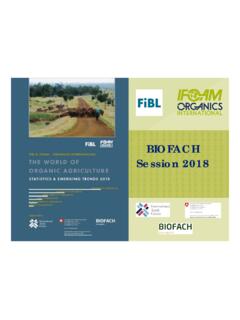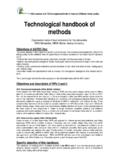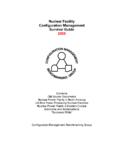Transcription of The use of gross and net margins in the economic …
1 The use of gross and net margins in the economic analysis of organic farms Chris Firth HDRA, Ryton organic Gardens, Coventry, CV8 3LG UK ABSTRACT In order to assess the technical and economic efficiency of conventional farm businesses a variety of management techniques have been developed. These include gross and net margin analysis and full cost accounting. This paper reviews their effectiveness in organic farming systems and finds that all of the techniques can be useful in helping to assess the economic efficiency of individual enterprises within an organic farming business, although they have their limitations.
2 organic systems require the integration of a number of usually complementary enterprises and therefore gross and net margins for particular enterprises taken out of the rotational or whole farm context can be misleading. Consequently it is important that any economic investigation of an organic system also includes whole farm economic analysis . Key words: gross margin , net margin , organic farming INTRODUCTION Many of the early converts to organic farming did so for non financial reasons, however, more recent conversions have been made by established farming businesses attracted by the commercial gains to be made from the change.
3 As the supply of organic food increases the market is becoming more competitive and profit margins in many sectors are being eroded. Thus, there is increasing need to study the technical and economic efficiency of organic farming. For this purpose a number of farm management tools, such as gross and net margins can be used. This paper will review and assess the usefulness and appropriateness of these tools when used to assess the economic efficiency of resource use in organic farm businesses.
4 economic analysis TECHNIQUES The process of analysing a farm business has been traditionally divided into two parts (MAFF, 1980); general analysis based primarily upon financial accounts and other appropriate records and an a more detailed analysis of the individual enterprises on the farm in the form of gross margins for each enterprise. In recent years, with the increasing economic pressure on agriculture, there has been a greater use of cost accounting techniques which result in net margin or profit per enterprise.
5 gross margins A gross margin for an enterprise is its financial output minus its variable costs (Table 1). The use of gross margins became widespread in the UK from about Archived at , when it was first popularised amongst farm management advisers for analysis and planning purposes (Barnard and Nix, 1979). The gross margin per hectare or per head for crops and livestock can be compared with standards (published averages of what might be typically possible in average conditions) obtained from other farms.
6 gross margins , however, should only be compared with figures from farms with similar characteristics and production systems. With this reservation in mind, the comparisons can give a useful indication of the production and economic efficiency of an enterprise. In organic systems gross margins are also useful for farm planning and for making comparisons of enterprises, on the same farm , between organic holdings, or between conventional and organic enterprises (Lampkin, 2001).
7 Table 1: Comparison of organic and conventional peas using gross and net margins ( /ha). organic Conv. OUTPUT Marketable yield (t/ha) Price per tonne ( ) 200 75 Arable area payment 300 300 Total output ( /ha) 1000 585 VARIABLE COSTS ( /ha) Seeds ( organic 350kg/ha) 175 80 Fertilisers 35 13 Sprays (conventional includes herbicides) 24 98 Other (cleaning) 20 - Total variable costs ( /ha) 254 191 gross margin ( /ha) 746 394 ALLOCATABLE FIXED COSTS ( /ha) Cultivations (disc & power harrow) 54 54 Planting (drilling and rolling)
8 25 25 Mechanical weeding 63 - Spraying & fertilising 9 36 Combine harvest 90 90 Total fixed costs( /ha) 241 205 NET margin ( /ha) 505 189 Source: (HDRA, 2001) gross margins specifically for organic crops and livestock were first published in the organic farm Management Handbook in 1994 (Lampkin and Measures, 1994). It was noted in the preface to the first edition of this that these figures where best possible estimates for the physical and financial performance of organic crops and livestock enterprises.
9 With subsequent editions (1995, 1999, and 2001) the data has expanded to include additional enterprises. The figures have also become more robust in the light of the experience of an increasing number of organic farmers, and research projects with linked commercial farms which have systematically collected full accounts and enterprise data. There are, however, some important limitations to the use of gross margins in organic systems: Comparison of gross margins between enterprises with different Archived at cost structures can be misleading, particularly when conventional variable costs have been substituted by fixed costs in the organic context weed control by herbicides replaced by mechanical weeding (Table 1).
10 It is often inappropriate to consider the economics of a single enterprise, such as organic vegetables, outside the context of the whole farm rotation, which will often include fertility building crops (Table 2). This phase of the rotation may be considered a part of the costs of achieving high returns for potatoes or carrots. Also certain inputs applied on a rotational basis, with residual effects on subsequent crops such as organic manures need to have their costs spread over the whole rotation.














